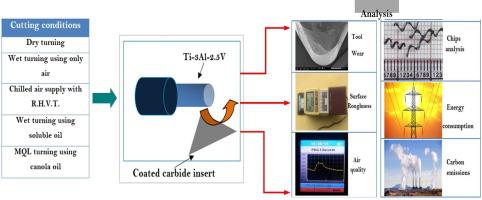Sustainable Energy Technologies and Assessments ( IF 7.1 ) Pub Date : 2020-09-10 , DOI: 10.1016/j.seta.2020.100806 Rupinder Singh , J.S. Dureja , Manu Dogra , Munish Kumar Gupta , Muhammad Jamil , Mozammel Mia

|
This paper investigates the turning of Ti-3Al-2.5 V with coated carbide tools under different cooling/lubricating environments to identify the sustainable and improved cooling/lubrication technology. Five different cooling/lubrication conditions (dry, pressurized compressed air-assisted wet cooling, cooling with Ranque-Hilsch-vortex-tube (RHVT), conventional MQL, and wet oil cooling) were selected and turning performance was evaluated in terms of air quality of the worker’s breathable/working zone, energy consumption, carbon emissions, tool wear, surface roughness, and chips analysis. From experimentation, it was found that under MQL the value of tool wear and surface roughness was lowest as compared to other cooling/lubricating conditions. But the generation of particulate matter of PM2.5 (150–305 mg/m3) under MQL was on alarming scale as compared to other cooling/lubricating environments. Further, energy consumption and carbon emissions with MQL was found to be lowest followed by RHVT, which was mainly due to effective cooling/lubrication provided by the lubricant in MQL and chilled air under RHVT. The comparison of RHVT and MQL environments indicate just 1.6–1.4% increment in energy consumed with the use of RHVT under both tested speeds. Further, under RHVT state 45%–56% reduction in carbon emission (at both MRR) in contrast to dry turning was observed. The generation trend of average PM2.5 particles under RHVT was comparable with that achieved under dry conditions. Results of the study clearly indicates that RHVT can act as sustainable cooling/lubrication techniques in terms of environmental, economic and technological aspects for turning of Ti-3Al-2.5 V.
中文翻译:

考虑Ti-3Al-2.5 V加工过程中的碳排放,评估能源和环境的可持续性支柱
本文研究了在不同的冷却/润滑环境下用涂层硬质合金刀具对Ti-3Al-2.5 V的车削过程,以确定可持续的和改进的冷却/润滑技术。选择了五种不同的冷却/润滑条件(干式,加压压缩空气辅助湿式冷却,Ranque-Hilsch-涡流管(RHVT)冷却,常规MQL和湿油冷却),并根据空气质量评估了转向性能工人的呼吸/工作区,能耗,碳排放,工具磨损,表面粗糙度和切屑分析。从实验中发现,与其他冷却/润滑条件相比,在MQL下刀具磨损和表面粗糙度的值最低。但是会产生PM2.5(150-305 mg / m 3与其他冷却/润滑环境相比,MQL的测量结果令人震惊。此外,发现使用MQL的能耗和碳排放量最低,其次是RHVT,这主要归因于MQL中的润滑剂和RHVT下的冷空气提供了有效的冷却/润滑。RHVT和MQL环境的比较表明,在两种测试速度下,使用RHVT的能耗仅增加1.6-1.4%。此外,在RHVT状态下,与干式车削相比,碳排放量减少了45%-56%(两个MRR)。RHVT下平均PM2.5颗粒的生成趋势与干燥条件下可比。研究结果清楚地表明,RHVT可以作为环境方面的可持续冷却/润滑技术,











































 京公网安备 11010802027423号
京公网安备 11010802027423号